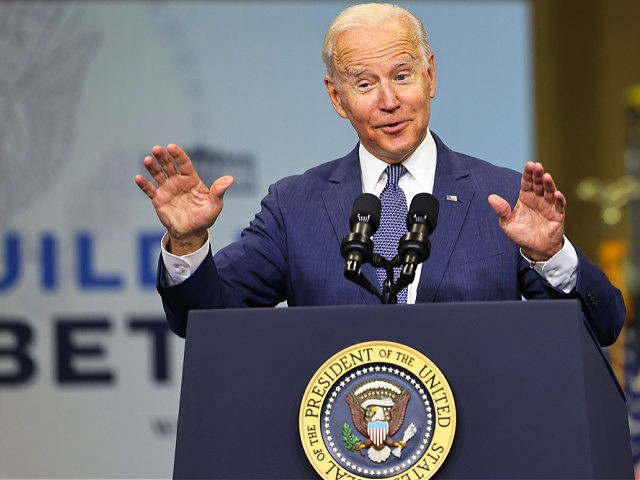The $1.2 trillion so-called bipartisan infrastructure bill allocated $65 billion on broadband investment with no obligation to develop a national broadband strategy.
Last week, the GAO released a report which found that, despite spending billions of dollars on closing the digital divide, the federal government has no “national strategy” to close the gap between Americans who have high-speed internet and those who do not.
Broadband programs have proliferated over many years and past administrations. “Federal broadband efforts are fragmented and overlapping, with more than 100 programs administered by 15 agencies,” the GAO reported. “Many programs have broadband as their main purpose, and several overlaps because they can be used for the purpose of broadband deployment, as shown in the figure.”
Although the GAO recommended a national strategy be developed, it also noted that the Joe Biden White House “has not decided if a national strategy is needed.”
New GAO report finds that the Administration has no national strategy guiding the federal government’s spending of billions of dollars on broadband infrastructure.
That’s like turning the spigot on full blast and walking away from the hose.
Taxpayers are bound to get soaked. pic.twitter.com/XRfbaNWW2U
— Brendan Carr (@BrendanCarrFCC) June 10, 2022
Federal Communications Commission (FCC) Commissioner Brendan Carr released a statement in reaction to the report underscoring the need for oversight and accountability as well as the need for a national strategy on American broadband deployment:
For over a year, I have been sounding the alarm on the troubling lack of oversight and coordination when it comes to the federal government’s expenditure of hundreds of billions of dollars that Congress appropriated for ending the digital divide. I have written letters to federal agencies charged with administering those funds to seek assurances that taxpayer dollars are not wasted, and in several cases those letters received no response at all. I have testified about the worrying lack of coordination across federal agencies and their respective programs. I have spoken out about the absence of adequate tracking, measurement, and accountability standards.
…
The Administration’s failure to put appropriate protections in place is troubling given both the volume of taxpayer dollars at issue and the importance of delivering on the shared goal of connecting all Americans. Indeed, it appears that the Administration has turned the spigot on full blast and then walked away from the hose. As a result, taxpayers are about to get soaked.
Spending hundreds of billions of dollars in an uncoordinated way only adds to the inflationary pressures that are already hitting Americans in their pocketbooks. Indeed, the failure to put a national strategy in place hampers efforts to build out broadband infrastructure at a point in time when telecom crews are already facing serious headwinds. Just last week, I participated in a broadband roundtable in South Dakota where providers stated that their costs to construct Internet infrastructure are up nearly 30% in light of inflation, rising fuel costs, supply chain challenges, and workforce shortages.
The Administration should put a national strategy in place to ensure that the federal government delivers on this opportunity to end the digital divide.
The lack of a national strategy for broadband raises questions about the $65 billion allocated through the $1.2 trillion so-called bipartisan infrastructure bill, otherwise known as the Infrastructure Investment and Jobs Act.
The Biden White House, 13 House Republicans, and 19 Senate Republicans have touted the benefits of the so-called infrastructure bill. Breitbart News has cataloged the leftist, woke, and other carveouts in the infrastructure bill, which has little to no conservative victories in the bill despite its moniker as a bipartisan bill.
The GAO report reviewed existing broadband programs and concluded that, as a whole, these programs lack a strategic focus. The nonpartisan organization suggested that the White House develop a plan to develop a national broadband program.
The GAO noted that two recent pieces of legislation, the Consolidated Appropriations Act of 2021 and the Infrastructure Investment and Jobs Act, “do not require NTIA [National Telecommunications and Information Administration] to develop a broadband strategy.”
Dustin Carmack, a research fellow for the Center on Technology Policy at the Heritage Foundation, described this as a “hot mess” at the “taxpayers’ expense.”
Add the garden variety of other infrastructure/BIF programs/grants they’re rushing to cobble together on top of this and you’ve got yourself a good ol’ hot mess…at taxpayers expense. https://t.co/WiXlEix7Di
— Dustin Carmack (@DustinCarmack) June 10, 2022
The GAO explained a national strategy on broadband deployment could mitigate the overlap between “potentially duplicative” efforts from the over 100 federal government broadband programs.
The GAO wrote in its conclusion, “Greater direction through a national strategy led by the Executive Office of the President could guide agencies in working more collaboratively to close the digital divide.”
Editor’s Note: This story was revised to reflect that the $65 billion in broadband investment has been allocated but not yet spent and that the GAO recommends a national broadband strategy.
Sean Moran is a congressional reporter for Breitbart News. Follow him on Twitter @SeanMoran3.

COMMENTS
Please let us know if you're having issues with commenting.